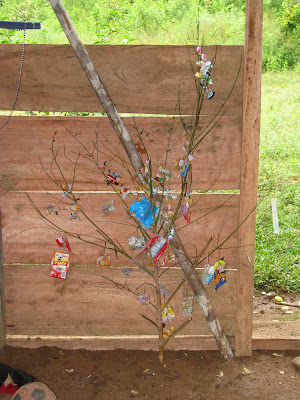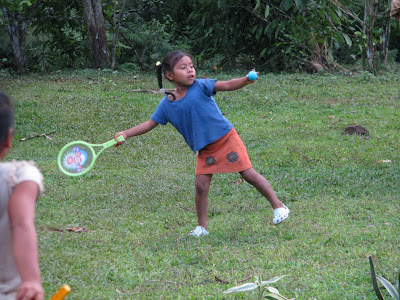Not really joking, I get similar looks all the time. Luckily, the timing on this shot was perfect as this kid was checking out my camera and try to figure out what the heck it was.






 And this is the house (compound.) The second floor of the house has the bedrooms, while the 2 panka (grass) roof houses to the left (only 1 is visible) are the living room and kitchen.
And this is the house (compound.) The second floor of the house has the bedrooms, while the 2 panka (grass) roof houses to the left (only 1 is visible) are the living room and kitchen. This is Yadi (pronounced Jadi,) the oldest of the kids. In this picture, she's practicing the traditional method of removing the rice husks. There's nothing complicated about it, you just pound the rice with that heavy club until the husks break open.
This is Yadi (pronounced Jadi,) the oldest of the kids. In this picture, she's practicing the traditional method of removing the rice husks. There's nothing complicated about it, you just pound the rice with that heavy club until the husks break open.




 A beautiful spot in town, and an example of the landscape.
A beautiful spot in town, and an example of the landscape. Good Parrot.
Good Parrot. Seth and I making tamales during Culture Week.
Seth and I making tamales during Culture Week. On top of a small hill behind the property of my host family during culture week. That´s my host father and two of his sons in the middle. On the left is Seth, who will be the closest Volunteer to me, and on the right is the other Josh in our group.
On top of a small hill behind the property of my host family during culture week. That´s my host father and two of his sons in the middle. On the left is Seth, who will be the closest Volunteer to me, and on the right is the other Josh in our group. Planting rice at the granja (farm.) A hard day´s work in the sun.
Planting rice at the granja (farm.) A hard day´s work in the sun. Making sugar cane juice. This machine is the traditional way of making sugar. The sugar cane would be crushed into a juice which would then be boiled to form discs of hardened sugar. We drank the juice straight from the machine which resembled muddy water and was unbelievably sweet.
Making sugar cane juice. This machine is the traditional way of making sugar. The sugar cane would be crushed into a juice which would then be boiled to form discs of hardened sugar. We drank the juice straight from the machine which resembled muddy water and was unbelievably sweet. This is where chocolate comes from (a cacao pod.) The pod is about a foot in length and contains quarter sized seeds that are used to make chocolate. The seeds a have a gooey white coating that is sweet, tart, and tastes a little like apple.
This is where chocolate comes from (a cacao pod.) The pod is about a foot in length and contains quarter sized seeds that are used to make chocolate. The seeds a have a gooey white coating that is sweet, tart, and tastes a little like apple. Balsa wood carvings done by one of the families in Membrillo. The white bird on the left is a harpy eagle, national bird of Panama.
Balsa wood carvings done by one of the families in Membrillo. The white bird on the left is a harpy eagle, national bird of Panama.